
John Betts - Fine Minerals > Home Page> Educational Articles > The Minerals of New York City > Page 2 |

Go to Previous Page, Page 1, Page 2, Page 3, Page 4, Next Page
In the Appendix to Gems & Precious Stones of North America (1890), George Kunz wrote:
"The finest garnet crystal ever found in the United States was discovered, strange though it may seem, in the midst of the solidly built portion of New York city, by a laborer excavating for a sewer in West Thirty-fifth Street, between Broadway and Seventh Avenue, in August, 1885. A quartzite vein, traversing the gneiss, contained the crystal. The laborer took it to Mr. J. J. King, who lived in the vicinity, from whom the author received it, and it is now deposited as a loan in the cabinet of the New York Mineralogical Club, at the American Museum of Natural History, Central Park, New York."
|
The Subway Garnet, a 15 cm almandine crystal from 35th Street between 7th
Avenue and Broadway in |
This large single crystal has become known as the Subway Garnet or the Kunz Garnet and is truly an impressive specimen. It is a large single crystal, 15 cm across, of red-brown almandine garnet with no matrix attached. The crystal form is dominated by trapezohedral faces with dodecahedral corner modifications. The crystals faces are smooth and clean with no remnants of the surrounding matrix. A few corners and faces on the rear are incomplete where the crystal was attached to the surrounding matrix. Currently there is green-gray epoxy on the rear from when the crystal was mounted in an exhibit on public display at the AMNH. The large size, well developed crystal form and unusually clean surfaces make this one of the best, if not the best, single crystal of almandine garnet found in the US.
There is some confusion about who actually discovered this large garnet (Betts, 1997). William Niven disputes Kunz account above, claiming that he received the specimen from a laborer at 35th Street at 3rd Avenue, and offered it for sale for $100, when it was purchased by Kunz (not named by Niven, but there is no doubt whom he meant). I believe that Kunz's penchant for self-promotion led him to obscure his source for the crystal, and that Niven, writing 38 years later and tired of being omitted, was attempting to set the record straight. Wilson (2006) interprets the Kunz story at face value but speculates that J.J. King was Niven's store attendant, who operated the business during Niven's absences. This is a big assumption with no substantiation - the name J.J. King does not appear in any other references of the NYAS or the NYMC. Either Kunz obtained the garnet from Niven's store clerk and intentionally omitted the association with Niven or he received it from an acquaintance, King, as stated in his report.
The find was an important one as evidenced by the wide press it received in the journals of the time. An etching prepared by fellow NYMC member B.B. Chamberlin was reproduced in New York Academy of Sciences Transactions Volume 5 (1886), Gems & Precious Stones of North America (1890), The Minerals of Broadway (1914), The Minerals of New York City and Its Environs (1931), among others.
Note: Though the Subway Garnet is the best formed, most complete almandine garnet crystal from New York City, it is not the largest. A 23 cm almandine garnet was found at 171st Street and Fort Washington Avenue.
Two important finds of chrysoberyl were made by Wallace Goold Levison (1846-1924), a prolific collector of New York City minerals, active member in the New York Mineralogical Club, the first editor of American Mineralogist (founded in 1916). He is credited with creating the first motion picture camera that predated, but anticipated, the invention of roll film. The importance of these chrysoberyl finds resulted in repeated stories in mineralogical literature of the time (Levison, 1901a, 1901b, 1901c; Moses, 1901; Gratacap 1909, etc.) and numerous lectures at scientific societies
The first chrysoberyl find, on the north side of 88th Street east of Amsterdam Avenue, was made June 16th, 1893 in a large block of granite pegmatite that had been excavated during construction. The block was placed near the sidewalk where Levison discovered the chrysoberyl exposed on the surface of the block. Using a handy rock, he was able to break off the portion containing the chrysoberyl crystal. After trimming, the chrysoberyl crystal measured 13 mm high, is exposed on all sides, and is attached to a small block of smoky quartz and albite. The chrysoberyl is dark yellow-green color, with lustrous faces on most sides. The crystals are V-twinned and idealized crystal diagrams were prepared by Prof. A.J. Moses of Columbia University and used in several of the publications about the find.
|
Chrysoberyl from 88th Street east of Amsterdam Ave., Manhattan, collected by Wallace Goold Levison, June 16th, 1893, 22 mm high. NYMC #691 |
|
Idealized diagram of the chrysoberyl from 88th Street east of Amsterdam Ave.,
Manhattan |
Levison returned to the site the next day, this time with appropriate tools, but failed to find any addition crystals of any notable mineral, though he reported another collector found a green mineral assumed to be epidote.
Nine years later, in 1901, Levison made a second discovery of an even larger chrysoberyl crystal at 93rd Street in Riverside Park. A large mass of gneiss was exposed to 50 feet high for two blocks. Levison recognized the exposure, cut by veins of lighter gneiss and lenses of quartz and albite, as similar to the formation of his first find of chrysoberyl 350 meters away to the southeast. He repeatedly visited the site during August 1901 when on the 31st of the month a fine chrysoberyl specimen was discovered by a companion who was there to photograph the site for Levison.
The specimen is an elongated plate of garnetiferous smoky quartz 16 cm across by 13 cm high. Embedded in the quartz are six segments of a glassy transparent yellow-green chrysoberyl crystal that must have broken during the quartz intrusion. The two largest chrysoberyl sections measure 25x25 mm and 23x20 mm. Levison (1901c) in his article for The Mineral Collector magazine misstates the dimensions in centimeters - his dimensions should be millimeters. Each section is about 8 mm thick at the edges, but of unknown thickness because they are embedded in the quartz. The six crystal sections do not represent the full crystal that must have exceeded 60 mm, presumably because other portions were lost in adjacent quartz. The luster and transparency of the chrysoberyl are impressive when the specimen is seen in person.
|
Chrysoberyl in Quartz from 93rd Street at Riverside Drive, Manhattan, collected
by Wallace Goold Levison, August 31, 1901, |
Over the years the executive committee of the NYMC made repeated attempts to obtain these chrysoberyl specimens from Levison. It was not until eleven years after Levison's death in 1924 was the NYMC able to purchase the specimens from his nephew in 1935. Both specimens are currently in the collection of the NYMC (Nos. 690 and 691) residing at the AMNH for safe keeping.
In 1888 a young student, Gilman Stanton discovered an extraordinary find of sharp, well crystallized almandine garnets in a pegmatite exposed at a construction site near 65th Street where it crosses Columbus Avenue and Broadway, near the current site of the Julliard School of Music and Lincoln Center for the Performing Arts. Following is Gilman Stanton's description of the find from the Transactions of the New York Academy of Sciences (1891) v.10, p. 50-51:
"Nearly three years ago I first discovered that this vein contained a remarkable quantity of interesting, beautiful, and exceedingly perfect crystals of garnet. For about a month, while the blasting continued, I succeeded in getting a large number of specimens. The vein, which was coarse granite cut a light-colored of the gneiss of this city and averaged some three feet in width. The mica of the granite was muscovite, often in imperfect crystals seven inches [18 cm] across and as much in thickness. The smoky quartz and orthoclase occurred in correspondingly large masses, the orthoclase sometimes being crystallized.
The garnets were most beautiful at the junction of these two minerals, usually upon a face of an orthoclase crystal. The garnet faces in the orthoclase were generally flattened, as the numerous shallow casts on the specimens here indicate. Crystals from the smoky quartz were fewer, but much lighter in color and more translucent. Some of the groups of garnets are very beautiful. One consists of fifty-nine crystals about three-eighths of an inch [5 mm] in diameter, and nearly as many more in casts, on a part of an orthoclase crystal ten by eight by four inches.
An interesting feature of the garnets was their crystalline form. They were the combination of trapezohedron truncating the rhombic dodecahedron, the faces of each being about equally prominent. The largest crystal was one and a quarter inches [32 mm] in axial diameter. Few were less than one-quarter of an inch [6 mm]. One specimen on the table shows faces of the hexoctahedral, in addition to those mentioned, thus giving the crystal the appearance of rounded edges.… To my knowledge no simple dodecahedrons were found."
|
Almandine Garnet from 65th St. and Broadway, Manhattan, NY ex. Kunz. 16x7 cm NYMC #188. |
The almandine crystals were not large, they averaged 10 to 25 mm in diameter. But their clean surfaces, high luster and contrasting matrix made them particularly attractive mineral specimens. It is reported in the New York Times (June 1, 1913) that eventually a mineral dealer (Niven?) completely excavated the find, and over 1,000 garnets were recovered, a fact verified by the their widespread representation in mineral collections today.
One of the best specimens from this find is in the NYMC mineral collection, residing at the AMNH. The specimen measures 15 cm x 13 cm and has almandine crystals 5- 20 mm across, on contrasting microcline and smoky quartz matrix.
The carbonate minerals found in seams in the serpentine of Staten Island were first described by Pierce (1818) as crystallized carbonate of magnesia. During the 1960s a housing boom led to the development of rural areas of Staten Island in the serpentine highlands. A serpentine exposure near Spring Street was discovered by local mineral collectors and worked extensively producing fine specimens of artinite and hydromagnesite. The largest specimens exceeded 45 cm across. The artinite formed fine, white coatings and hemispherical sprays of crystals to 25 mm long in narrow seams running through greenish serpentine matrix. Smaller hemispherical crystal aggregates to 2 mm across of white hydromagnesite and hexagonal bronze-colored pyroaurite to 1 mm crystals are frequently associated with the artinite. Octahedral microcrystals of magnetite are found throughout the deposit (Reasenberg, 1968). Both the artinite and hydromagnesite fluoresce white under ultraviolet illumination. Later, a nearby sewer excavation produced a second find of artinite and hydromagnesite. Today remnants of the serpentine knoll still exists near Emerson Court and Spring Street, but is closed to collecting and is fenced off.
|
Artinite and hydromagnesite from Spring Street, Staten Island, 15 x 8 cm, author's collection. |
During the research for this article the author viewed many private collections and museum collections, inspecting over 1500 NYC minerals specimens and photographing 250 of the most noteworthy specimens. All descriptions are based on firsthand observations of the specimens, unless specific historical references are cited. The limited space available for this article prevents the complete description of all mineral species found in NYC. Following is an overview of the significant minerals species and occurrences within city limits.
Note: NYC street names have changed over the years. Where possible the current street names are used (e.g. Park Avenue for the old 4th Avenue).
Compact masses of crystallized dark green to green-black actinolite is common throughout NYC. One of the best actinolite finds was in the Mott Haven section of the Bronx at Southern Boulevard and Brown Place, where actinolite crystals to 7 cm long were found associated with quartz and calcite.
Crystals of white to bluish albite are a common constituent of the pegmatites that are routinely found cutting the schists and gneiss. Some older specimens are labeled as "oligoclase", an obsolete mineral species, now considered a variety of albite. Albite crystals have been found throughout NYC associated with quartz, beryl, schorl and garnets. A large, well formed albite crystal 6 cm across on matrix from Manhattan is in the Chamberlin collection currently resides in the NYMC collection. The variety peristerite was found at 16th Street and Fort Washington Avenue in northern Manhattan.
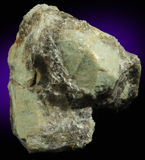
#337, Albite var. Oligoclase, west shore of
Manhattan Island at 102 Street, New York
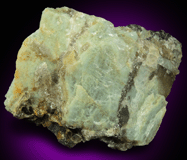
#356, Albite var. Oligoclase, west shore of
Manhattan Island at 102 Street, New York
Several occurrences of black allanite-(Ce) were noted in the city, often labeled as orthite, an obsolete name for this mineral. Noteworthy specimens include a 20 mm prismatic black allanite-(Ce) crystal found at the southeast corner of 56th and Broadway embedded in albite pegmatite currently in the SIIAS collection and a 25 mm black allanite-(Ce) crystal embedded in quartz from the Brooklyn-Battery Tunnel connecting lower Manhattan Island to Brooklyn in the NYMC collection. Both specimens show segmentation and curvature of the allanite-(Ce) crystal due to post-crystallization deformation.
One of the most significant minerals species found in NYC is almandine garnet. Many large crystals to 23 cm across are known. It should be noted that the Subway Garnet, mentioned earlier, in the NYMC collection at the AMNH is not the largest almandine crystal found in NYC, but is the most complete and well formed almandine crystal from the city.
An interesting feature of NYC almandine is that almost all crystals show trapezohedral faces, with the large crystals being dominated by trapezohedral faces and the smaller crystals showing dodecahedral faces with pronounced trapezohedral edge modifications. The color of almandine ranges from opaque reddish-brown in the large crystals to translucent wine-red in the smaller crystals. Almandine has been found throughout the city associated with the pegmatite dikes and nearby alteration zones. The large crystals have smooth clean faces that formed against surrounding quartz matrix and show no signs of muscovite on the surfaces.
In 1882 W.F. Chamberlin exhibited a large partial crystal of almandine at the NY Academy of Sciences meeting. This crystal measured 12 cm across before it was extracted that came from 145th Street in Manhattan. The finest almandine crystal Chamberlin (1888) reported measured 75 mm across and was found in front of the New York Times building in rock that probably was excavated at 56th Street at Avenue of the Americas. He also reported large striated almandine crystals 100-125 mm across found at 144th Street at Brook Avenue in the Mott Haven section of the south Bronx, the best showing 22 complete faces and a "dull darkish brown" color.
As mentioned previously, one of the best finds from NYC was the almandine crystals found at 65th Street and Broadway that were sharp, well-formed dark brown crystals often on contrasting microcline or quartz matrix. In midtown Manhattan, garnets were also found in an area from Broadway to 7th Avenue from 30th-36th Streets, with the most noteworthy specimen from that area being the Subway Garnet measuring 15 cm across. In 1908, a mineral collector discovered a complete garnet crystal in a pile of blasted rock at 33rd Street and learned from the workers that the excavated rock was being dumped as fill at Sheepshead Bay, in southern Brooklyn. Upon visiting the site he discovered garnet-rich schist throughout the rock fill and this site became a favorite collecting spot for many years.
|
Almandine garnet crystals 7-14 mm across from 65th Street Broadway, Manhattan,
NY ex. Stanton in 1888. |
In northern Manhattan pods of red-brown almandine garnets were found at the xenotime locality at 185th Street along the Harlem River. The almandine was crystallized in parallel orientation and the largest crystal found was 23 cm across (Hovey, 1896a). Miller (1910) reported finding cinnamon-colored garnets to 10 cm across in upper Manhattan Island, near 171st Street and Fort Washington Avenue. A little to the south, at the excavation for the Columbia Presbyterian Medical Center at 166th Street a large red-brown garnet crystal was found measuring 14 cm across. The crystal is not fully formed on the sides and shows a combination of trapezohedral and dodecahedral faces. This specimen is now on display at the AMNH in a display of large mineral crystals, labeled simply as from New York, New York.
|
Large almandine garnet similar in size to the Subway Garnet from West 166th
St. & Knowlton Place near the Medical Center, |
In 1967 almandine garnets in biotite schist were discovered in fill being dumped in the New Jersey Meadowlands, a tidal wetland area that was being "recovered" using fill from excavation sites in Manhattan. The source of the excavated material turned out to be a subway tunnel between 28th and 30th Streets at the Avenue of the Americas that was being excavated deep beneath two existing subway tunnels. Rothstein (1965) recounts, in his one-time opportunity to collect underground at this site, that garnets to 2.5 cm diameter were found in a dark seam of soft, decomposed schist about 15 cm wide.
A fine almandine crystal was collected in May 1970 by Dietmar Stitz from rock excavated for a bank building foundation on South Street in southern Manhattan and dumped as fill in the New Jersey meadowlands, where it was accessible to collecting. The almandine crystal is opaque reddish-brown measures 55 mm across and is perched on quartz matrix. The rear is incomplete, but the front faces show trapezohedral form with crystal faces composed of many smaller faces in parallel orientation. The faces are unusually lustrous and the complex texture of the surfaces makes this a very aesthetic specimen.
|
Almandine garnet 55 mm across on muscovite collected by Dietmar Stitz from
a bank excavation on South Street, Manhattan, New York City, |
On Staten Island an excavation at the foot of the Verrazano-Narrows Bridge produced plates of dark schist studded with small black to dark red almandine crystals to 9 mm across. Also on Staten Island, dark red almandine crystals to 20 mm across were found in the 1960s from rock excavated for the Richmond Aqueduct.
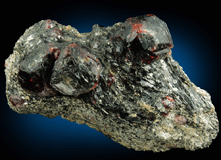
#336, Almandine Garnet, 26th Street at Sixth
Avenue Subway Excavation, Manhattan Island, New York
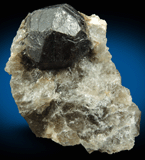
#374, Almandine Garnet, Manhattan Island, New
York
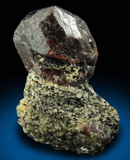
#354, Almandine Garnet, 26th Street at Sixth
Avenue Subway Excavation, Manhattan Island, New York
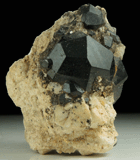
#363, Almandine Garnet, Broadway at 36th Street,
Manhattan Island, New York
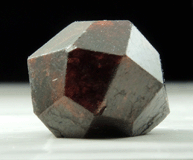
#349, Almandine Garnet, 65th Street at Columbus
Avenue, Manhattan Island, New York
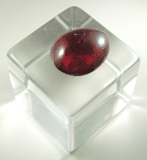
#364, Almandine Garnet (polished cabochon),
65th Street at Columbus Avenue, Manhattan Island, New York
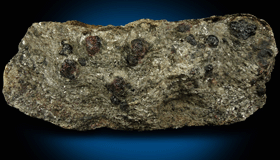
#326, Almandine Garnet in schist, near the Spuyten
Duyvil, northern Manhattan Island, New York
Recently translucent pink ancylite-(Ce) and honey-yellow calcioancylite-(Ce) crystals to 1 mm long were discovered on an old specimen of orange stilbite crystals that was collected at College Point, Queens in rock that was dumped there from the excavation of the 63rd Street subway tunnel. The ancylite-(Ce) crystals were in crevice between the stilbite crystals.
Compact masses of crystallized anthophyllite are widespread through NYC, notably from 59th Street and 11th Avenue in Manhattan in radiating brown crystals to 10 mm long. On Staten Island large masses of "fibrous serpentine" throughout the serpentine highlands were identified as anthophyllite.
A common serpentine mineral, antigorite is found as translucent blue-green fibrous masses often with curved, twisting shapes. Many large specimens were found in the serpentine deposits of Staten Island, notably at Grant City and from the serpentine found in west midtown Manhattan.
Presumably all old specimens labeled apophyllite are apophyllite-(KF). Lustrous white apophyllite-(KF) crystals are found filling seams in schist and gneiss. Many apophyllite-(KF) specimens have been recovered from Water Tunnel Nos. 2 and 3 under Manhattan, Bronx, Queens and Brooklyn. Beneath Roosevelt Island large plates to 21 cm across of colorless 1-12 mm transparent-to-translucent apophyllite-(KF) crystals were found by Dietmar Stitz during the early construction of Water Tunnel No. 3 in the 1970s, before the use of tunnel boring machines. Recently tabular translucent greenish apophyllite-(KF) crystals to 18 mm across were recovered from the tunnel in areas underneath Queens and Manhattan.
|
Large cluster of apophyllite over stilbite with quartz collected from Water
Tunnel #2 under Roosevelt Island. 21x16x8 cm. |
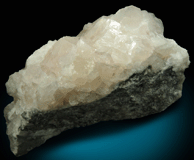
#373, Apophyllite, Water Tunnel No.3 under Manhattan
Island, New York
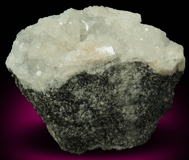
#366, Apophyllite, Water Tunnel No.3 under Manhattan
Island, New York
Several aesthetic specimens of aragonite are represented in major NYC collections. Aragonite was found in the 1970s at a road cut on the south side of I-278 on Staten Island as plates of elongated, tapered translucent crystals to 5 mm long that were colorless except for brownish limonite stains. At 215th Street and Broadway in Manhattan, in the Inwood marble, a 9x8 cm plate of creme-colored aragonite crystals was found by James Manchester. The aragonite crystals formed rounded fingers that resemble miniature stalactites to 3 mm long.
|
Aragonite from I-278 road cut (south side) on Staten Island collected 1970s
by Lynch, 9x3.5 cm, 1-5 mm crystals. |
First noted from the serpentine deposits of Staten Island (Pierce, 1818) artinite is found as acicular white crystals to 25 mm long in radiating aggregates lining veins running the through the greenish serpentine in association with hydromagnesite, magnetite and pyroaurite. The most noteworthy locality for artinite is the serpentine exposure off Spring Street, east of Todt Hill, Staten Island. But artinite is widespread and almost any exposure in the serpentine has potential for finding artinite microcrystals in thin seams.
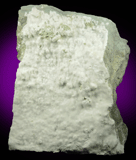
#324, Artinite, Spring Street at Medford Road,
Staten Island, New York
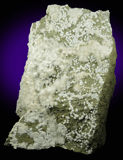
#323, Artinite and Hydromagnesite, Spring Street
at Medford Road, Staten Island, New York
Found in the pegmatites that cut the schist and gneiss, beryl has been found in crystals to 25 cm long. The locality at 190th Street and Amsterdam Avenue in upper Manhattan Island produced stout greenish-tan hexagonal beryl crystals to 9 cm across. At the 65th Street and Broadway garnet find, Gilman Stanton reported finding segments of a 25 cm long beryl prism frozen in smoky quartz matrix.
|
Beryl from 190th Street and Amsterdam Ave, Manhattan, ex. G.F. Kunz, 9 x 7 cm, NYMC #69 |
|
Beryl from 190th Street and Amsterdam Ave, Manhattan, NY ex. Kunz, 9x7.6x6 cm NYMC collection. |
The highlight of James Manchester's NYC collection was a set of seven faceted aquamarine beryl gemstones that were pictured in his book (1931) in Plate No. 1 opposite the title page. The largest of these gemstones weighs 1.5 carats. It was reported in the New York Times (June 1, 1913) that the collectors of the time considered it the finest gemstone from Manhattan Island. The same illustration in Manchester's book shows two gemstones of heliodor, the yellow gem variety of beryl, that were found at 158th Street and Broadway.
One specimen of bournonite was found by William Hidden at Park Avenue at 80th Street in Manhattan (Chamberlin, 1888) but there is no known specimen in the collections researched for this article. Hopefully this article will prompt further investigation and the specimen will be located.
See description under Ancylite-(Ce)
Widespread throughout all boroughs, calcite commonly occurs as late-forming crystals filling seams and cavities. In northern Manhattan and the Bronx, calcite is found in lenticular cavities in the Inwood marble as translucent scalenohedral crystals associated with colorless quartz crystals.
|
Calcite from 54th Street and Avenue of the Americas, NYC. 6x4x4 cm. Steve Nightingale collection. |
Noteworthy finds include translucent yellow scalenohedral calcite crystals to 70 mm long from 174th Street and Grand Concourse in the Bronx with faces coated with "mountain leather" a fibrous amphibole; yellowish calcite crystals to 70 mm from East 167th Street in the Bronx; elongated scalenohedral transparent calcite crystals to 15 mm long from 54th Street at Avenue of the Americas in Manhattan; thin white rhombic platy crystals found in 1874 during the expansion of the New York and Harlem Railroad tunnel under Park Avenue (Chamberlin, 1888); white prismatic, hexagonal calcite crystal to 65 mm long from the unused exit road cut east of Slosson Avenue on the south side of I-278 in Staten Island.
|
Calcite from East 174th Street at Grand Blvd, Bronx, NY., ex. Manchester
(illustrated in Plate No. 3 |
In 1973 Dietmar Stitz collected minerals from Water Tunnel No. 3 underneath Roosevelt Island and recovered large groups of thin, intersecting calcite crystals, with single crystals to 15 cm long. Because the calcite crystals filled the entire cavity most show cleavage faces around the edges where they were separated, but he was able to collect individual crystals that were complete, some with pyrite microcrystals on the faces. He also collected smaller colorless calcite crystals associated with red-brown stilbite from fault zones, where both minerals coated fractured plates of gneiss. Many of these specimens exceeded 50 cm across.
A particularly distinctive calcite locality represented in the NYMC collection was in the Calvary Cemetery in Queens near the current intersection of I-278 (Brooklyn-Queens Expressway) and I-495 (Long Island Expressway). Here was found a plate of scalenohedral calcite crystals to 50 mm long with select faces overgrown with a second generation of calcite microcrystals.
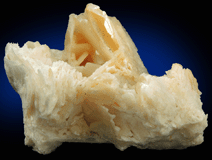
#343, Calcite, Water Tunnel No.3 under Roosevelt
Island, New York
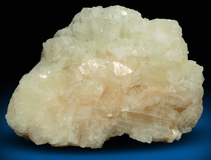
#346, Calcite, 63rd Street Subway Tunnel, Manhattan
Island, New York
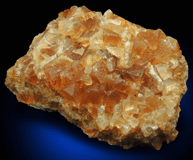
#372, Calcite, Water Tunnel No.3 under Roosevelt
Island, New York
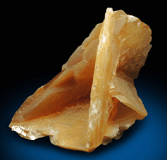
#347, Calcite, Water Tunnel No.3 under Roosevelt
Island, New York
Go to Previous Page, Page 1, Page 2, Page 3, Page 4, Next Page
Online Museum of New York City minerals
John Betts - Fine Minerals Home Page
Please support our sponsor
© The Minerals of New York City, by John H. Betts - All Rights Reserved